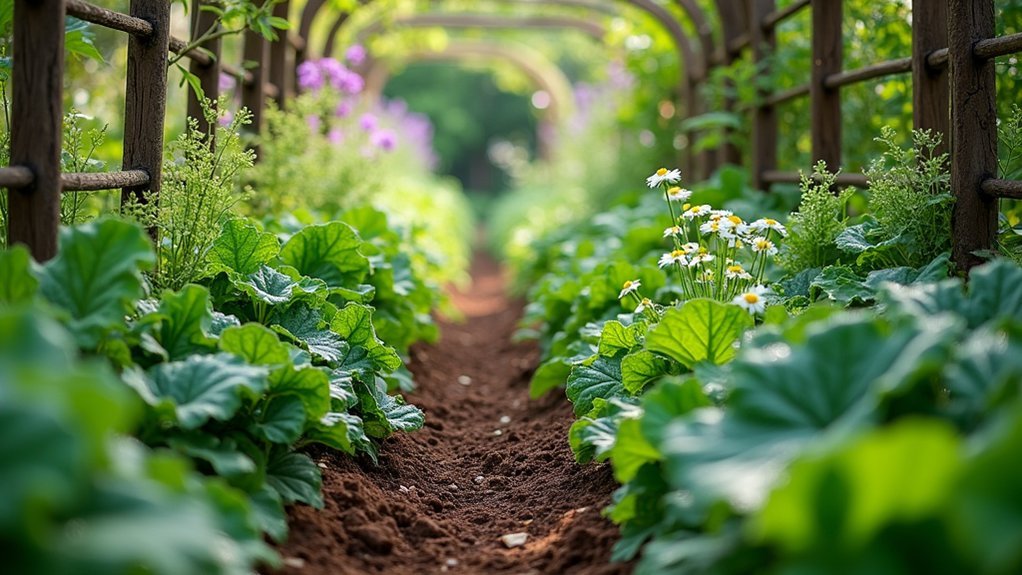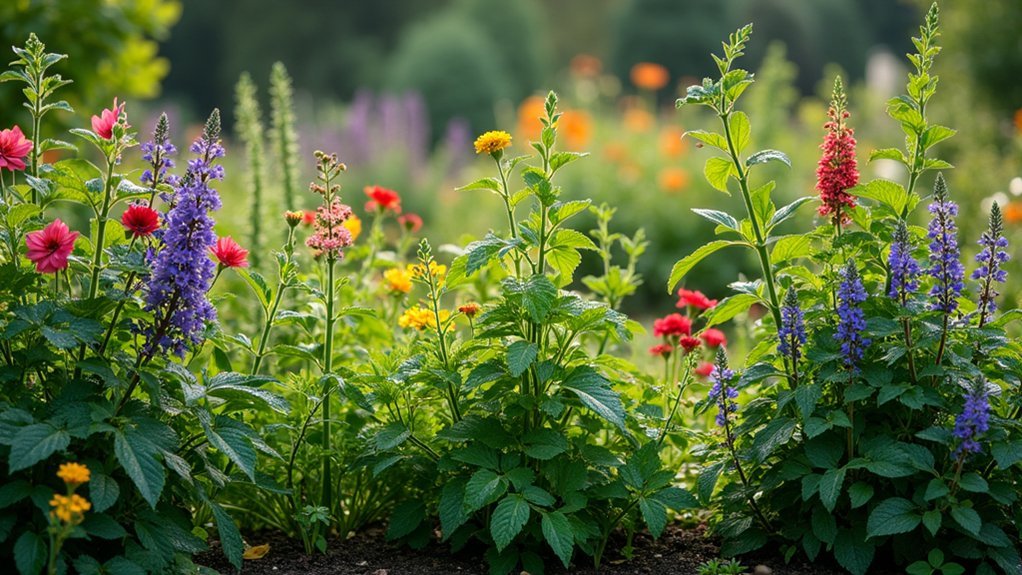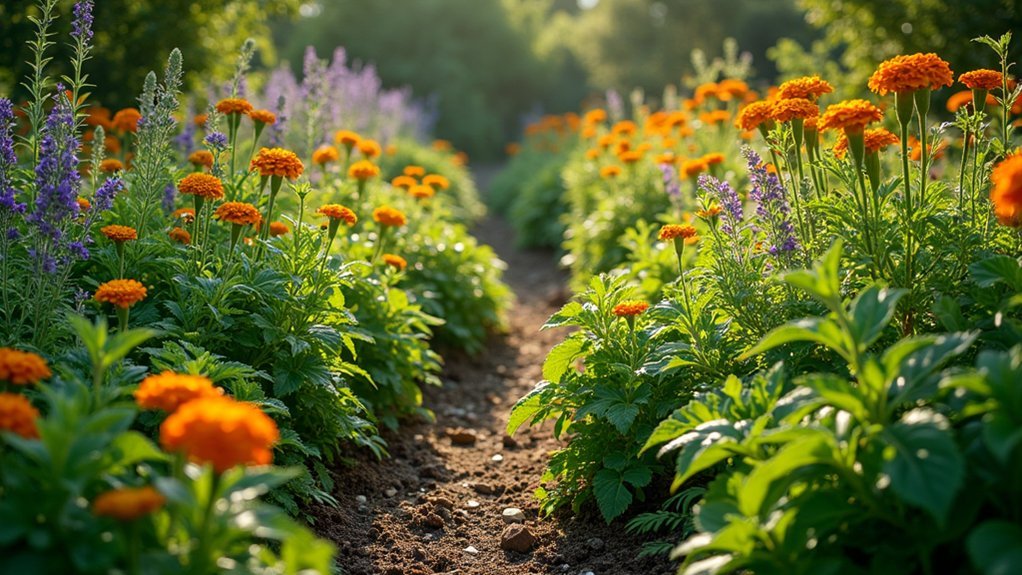Healing garden borders with edible plant fences offer dual benefits of beautiful boundaries and medicinal harvests. You can create layered designs using foundation herbs like yarrow, lavender, and peppermint as natural barriers. For year-round productivity, mix seasonal producers like holy basil and Malabar spinach with evergreens. Include bee-friendly clusters to support pollinators, and implement companion planting with aromatic herbs for pest resistance. These living fences transform ordinary garden edges into therapeutic spaces that nourish both body and spirit.
Foundation Herbs: Creating Medicinal Boundaries

While many gardeners focus solely on ornamental value when designing borders, medicinal herbs offer a powerful dual purpose as both healers and natural boundaries.
Consider yarrow, with its antiseptic and anti-inflammatory properties, which creates an effective perimeter that protects both your garden and your health.
Lavender establishes a calming boundary that reduces stress while defining garden edges. Incorporating lavender along pathways can help create an environment that actively relieves anxiety through its soothing aromatherapeutic properties.
Chamomile provides digestive and mild sedative benefits as it creates aesthetic borders.
Peppermint acts as a living fence while offering digestive relief and invigorating aromas that naturally repel pests.
These foundation herbs create more than just visual borders—they establish protective zones that deter unwanted insects, support beneficial pollinators, and offer easy access to healing plants whenever you need them.
Their aromatic compounds and medicinal properties work together to create truly functional garden boundaries.
Layering Healing Plants for Therapeutic Garden Edges
Beyond simple garden organization, therapeutic layering transforms ordinary borders into multidimensional healing spaces that engage all your senses. By applying permaculture principles, you’ll create garden edges that heal and nourish both body and mind. These thoughtfully designed borders can significantly reduce cortisol levels while providing a natural boundary for your healing space.
| Layer Level | Plant Types | Therapeutic Benefits |
|---|---|---|
| Canopy | Small fruit trees, tall herbs | Visual boundary, shade, wildlife habitat |
| Middle | Flowering shrubs, medicinal bushes | Fragrance, biodiversity support, anxiety reduction |
| Ground | Creeping herbs, edible groundcovers | Erosion control, stress relief, accessibility |
| Root Zone | Bulbs, root vegetables | Seasonal surprise, soil health, purposeful harvesting |
When you integrate plants of varying heights, textures, and functions, you’ll maximize both space and healing potential. Plan for sequential blooming to guarantee year-round therapeutic benefits while engaging touch, taste, sight, and smell simultaneously.
Four-Season Medicinal Fence Designs for Continual Harvests

Creating a medicinal fence that produces year-round harvests requires strategic plant selection and thoughtful design.
Combine spring producers like butterfly pea and holy basil with summer staples such as moringa and Malabar spinach. For autumn, incorporate Indian jujube and air potato, while winter coverage comes from babul and giloy.
Every season offers its healing treasures—spring’s butterfly pea alongside summer’s moringa, autumn’s jujube complementing winter’s protective babul.
Structure your fence with a deciduous-evergreen mix, using sesbania for quick growth and thorny barberry for security. For additional privacy and colorful accents, consider adding upright Waga Vajilla shrubs that grow over 5 feet tall. Space deep-rooted species like moringa 8-10 feet from shallow-rooted plants to minimize competition.
Maintain productivity through seasonal pruning—trim barberry in late winter and coppice sesbania annually for fresh fodder growth.
Interplant holy basil as a natural pest deterrent, and use adulsa leaf litter as medicinal mulch. This approach guarantees both protection and healing benefits throughout the year.
Bee-Friendly Healing Borders: Combining Medicine and Pollinators
Healing gardens reach their full potential when they serve both human and pollinator needs simultaneously. By planting medicinal favorites like bee balm, lavender, hyssop, milkweed, and coneflower in dense clusters, you’ll create vibrant healing borders that bees can easily locate.
Design your borders with varied bloom shapes and staggered flowering times to support diverse pollinators throughout the growing season. Include vertical elements like taller milkweed varieties to provide shelter for beneficial insects. Plant pollinator-friendly options in masses of 3’x3′ to ensure they effectively attract and sustain beneficial insects.
You’ll enjoy multiple benefits from this integration: pollinators increase your medicinal yields through improved pollination, while your plants provide essential nutrition for declining bee populations.
Choose disease-resistant varieties like mildew-resistant bee balm, and plant in partial to full sun for ideal medicine production and pollinator activity.
Companion Planting Strategies for Medicinal Fence Resilience

Strategic companion planting transforms ordinary fence borders into resilient living ecosystems that protect and enhance your medicinal herbs. By integrating diverse plant species, you’ll create natural pest deterrents while fostering beneficial relationships between plants.
Position aromatic herbs like basil and mint alongside vulnerable medicinal varieties to repel pests naturally. Remember to consider that mint has aggressive growth habits and requires careful placement to prevent it from overtaking neighboring plants. Include marigolds and sage to further strengthen your garden’s defense system without chemicals. Add flowering herbs that attract pollinators, boosting the reproduction and yield of your medicinal plants.
Beyond protection, these companions improve soil health by increasing nutrient availability and supporting beneficial microorganisms.
You’ll maximize your garden space while creating habitats for beneficial wildlife. This permaculture approach guarantees your medicinal fence borders aren’t just productive but also self-sustaining, requiring less maintenance while delivering higher yields.
Frequently Asked Questions
How Do Medicinal Fence Plants Interact With Existing Landscaping Irrigation Systems?
You’ll need to adapt your existing drip irrigation systems for medicinal fence plants, ensuring they deliver water directly to roots without wetting leaves. Install pressure regulators and timers for ideal watering efficiency.
Can Edible Fence Plants Cause Allergic Reactions to Neighboring Property Residents?
Yes, your edible fence plants can trigger allergic reactions in neighbors. Plants with irritant sap like Euphorbia or those causing contact dermatitis may affect sensitive individuals nearby when pollen or sap travels across property lines.
What Legal Considerations Exist for Medicinal Plants Visible From Public Spaces?
When your medicinal plants are visible from public spaces, you’ll need to avoid therapeutic claims on signage, comply with local zoning laws, prevent attractive nuisance risks, and guarantee toxic plants aren’t accessible to passersby.
How Do Healing Garden Borders Affect Property Value and Neighborhood Perceptions?
Well-designed garden borders boost your property value by 10-20% and create positive neighborhood impressions. They’re seen as signs of care and environmental consciousness, making your home more marketable and your community more desirable.
Which Healing Fence Plants Are Safe Around Households With Curious Pets?
You’ll want to choose pet-safe options like boxwood, viburnum, rosemary, snapdragons, and creeping thyme. Avoid toxic plants such as sago palms and yew. Always use organic methods instead of chemical pesticides.
In Summary
You’ve now discovered how to transform ordinary garden borders into healing sanctuaries that nourish both body and spirit. By incorporating medicinal plants into your fences, you’ll enjoy year-round harvests while creating resilient, pollinator-friendly boundaries. Remember, your garden’s edge isn’t just a border—it’s an opportunity to grow wellness. Start small, expand gradually, and soon you’ll be harvesting health directly from your living fences.





Leave a Reply